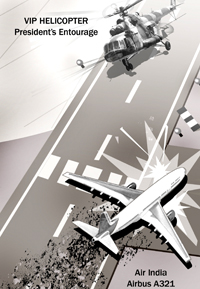INDIAN ARMED FORCES CHIEFS ON
OUR RELENTLESS AND FOCUSED PUBLISHING EFFORTS

SP Guide Publications puts forth a well compiled articulation of issues, pursuits and accomplishments of the Indian Army, over the years

I am confident that SP Guide Publications would continue to inform, inspire and influence.

My compliments to SP Guide Publications for informative and credible reportage on contemporary aerospace issues over the past six decades.
Miraculously Saved

Prima facie, the close shave between an Air India aircraft and IAF helicopter carrying President Pratibha Patil appears to be a case of two different air movements converging on the same spot
February 9. Mumbai Airport. 09:17:38 hours. Indair 866 stop immediately, Indair 866 stop immediately, due traffic! The air traffic controller shouted in his mike to the now speeding-fortakeoff Airbus A321 of Air India (AI). The panic call was repeated with greater urgency at 46th second of the minute. Finally, Captain S.S. Kohli acknowledged the tower’s call and aborted take-off 10 seconds later. By this time he had also seen the conflicting traffic: an Mi-8 of the IAF’s VIP squadron which had touched down right in front of him on runway 27. Engaging full thrust reversers and slamming hard on the brakes, he managed to avert a horrifying collision with the VIP helicopter by managing to slow the aircraft down sufficiently to clear the runway on a fast exit taxiway. The aircraft which, by this time, had burst tyres and smoking wheel-drums, was promptly attended to by the airport’s firefighting and safety services ensuring no further damage to the Airbus A321. All 148 passengers and 7 crew members of the Delhi-bound flight were recovered safely.
Everyone around the Chhatrapati Shivaji International Airport heaved a sigh of relief wherein an inevitably disastrous accident was converted into a close shave by the justin-time reactions of the Airbus commander, Captain Kohli. It also spared the nation monumental shame and international embarrassment as the accident—had it occurred—would have involved the Presidential entourage travelling in the helicopter. No sooner had Captain Kohli been elevated to the status of a national hero than the blamegame began. Radio telecommunication recordings between the Air Traffic Controllers (ATCOs), Indian Air Force (IAF) and AI pilots were confiscated by officials of the Directorate General of Civil Aviation (DGCA). The nearmiss immediately triggered a by now customary confrontation between civil aviation authorities and the IAF. While the civil side maintained that the IAF’s VIP helicopter had not checked with Mumbai tower control before landing, the IAF contended that the pilots of President Pratibha Devisingh Patil’s helicopter entourage followed instructions to the letter. The incident even prompted the IAF Chief, Air Chief Marshal Fali Homi Major, to interject by stating that the IAF helicopters had committed no mistakes. No aircraft or helicopter can change its frequency without being told to do so by the ATC (Air Traffic Control). The three IAF helicopters were cleared to take off from the naval airbase INS Kunjali and headed for Santa Cruz on the approach frequency. They adhered to the same frequency and were specifically cleared to land on Runway 27, Major said, disputing the claim that the approach had asked one of the helicopters (Pratap-1) to change over to the tower control frequency. Why they were on separate frequencies, the ATC has to answer.... If there is a need to fine-tune procedures and coordination, it is for civil aviation authorities, like the DGCA and ground ATC, to do so, he stressed. Reacting to Major’s defence of his pilots on the eve of the inauguration of Aero India 2009 air show, Civil Aviation Minister Praful Patel said, It would be premature to comment until the probe is completed on both sides. Somewhat peeved, the minister added that he did not know on what basis the IAF Chief had handed his pilots a clean chit. Maybe he has better information from his side.
Prima facie, it appears to be a case of two different air movements converging on the same spot (Runway 27) from opposite directions, one in the process of landing and the other speeding for take-off, without any prior knowledge of each other’s presence. A plausible reason: the conflicting traffic were operating on different radio frequencies. Normally, all landings and take-offs are carried out on the tower frequency on which the concerned ATCO controls the aerodrome traffic. After take-off, the departing traffic is handed over to the approach control on approach frequency for further instructions on the outbound leg of the flight. Conversely, all inbound flights are handed over to the tower control before entering the aerodrome zone, generally at predetermined points, for landing.
Crucial to the normal procedure is the real-time interaction between the approach and tower controllers, ensuring total situational awareness on both their part. Under special circumstances, such as VVIP movements and emergency situations, landings may be permitted on approach frequency albeit with full knowledge of the controller on the tower frequency. For VVIP movements involving the Heads of State, special ATC procedures are laid out for smooth and uninterrupted conduct of these flights. Apart from the aerial security point of view, this is also done to meet the stringent requirements of the scheduled door opening/door closing times. It was not long ago that as much as half-an-hour gap was given between VVIP flights and the normal traffic both during departure and arrival timings of the former. However, with the unprecedented growth of air traffic in the last decade in India, a fresh thinking was given to this aspect to avoid large scale disruption of civil traffic and consequent heavy financial loss to civil operators. At the IAF controlled aerodromes, where the density of scheduled air traffic is low, the gap was brought down to 10 minutes. In the case of civil airports, this was further reduced to near real-time (less than five minutes) basically to lend priority to the VVIP movement. So what happened in this case?





